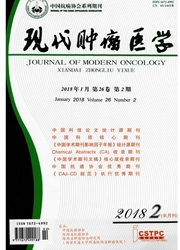

 中文摘要:
中文摘要:
目的:评价噬菌体展示肽GX1与胃癌新生血管结合的特异性及体内靶向性.方法:化学合成Bio-GX1展示肽;构建人胃癌移植瘤裸鼠模型,A组将Bio-GX1展示肽经尾静脉注入荷瘤小鼠体内,分别于体内循环8h、12h、18h、24h时处死裸鼠,B组将GX1噬菌体经尾静脉注入荷瘤小鼠体内,于体内循环8min时处死裸鼠,免疫荧光方法检测GX1噬菌体及展示肽与胃癌血管体内结合特异性及靶向性;构建小鼠肾包膜下胃癌移植瘤模型,分别于移植瘤术后第5天、第10天经尾静脉注入Bio-GX1展示肽,体内循环8h处死小鼠,免疫荧光方法检测GX1与胃癌血管体内结合的特异性及靶向性.结果:GX1展示肽体内循环8-24h,GX1噬菌体体内循环8 min,可特异靶向人胃癌移植瘤裸鼠胃癌组织血管,而与肝、心、脾、肾(脑)、肺、肌肉组织等对照组织血管未见明显结合;GX1展示肽体内循环8h,可特异靶向小鼠肾包膜下胃癌移植瘤模型肿瘤血管,与对照组织血管未见明显结合.结论:GX1噬菌体及展示肽均可在体内特异靶向胃癌血管,具有体内胃癌血管靶向性,可作为胃癌血管靶向治疗及诊断的有效候选分子.
 英文摘要:
英文摘要:
Objective:To evaluate the specific binding ability and targeting ability of phage displayed peptide GX1 to the vasculature of gastric cancer by trace technique in vivo.Methods:Bio-GX1 peptide was synthesized by chemosynthesis.Group A:Bio-GX1 peptide was injected into the tail vein of nude mice bearing tumor xenografts of human gastric cancer which were then kept for 8h,12h,18h,and 24h.Group B:GX1 phage was injected into the tail vein of nude mice bearing tumor xenografts of human gastric cancer which were then kept for 8min.Then immunofluorescence was done in Group A and B to evaluate the the specific binding ability and targeting ability of GX1 phage and peptide to the vasculature of gastric cancer.Bio-GX1 peptide was injected into the tail vein of immunosuppressed mice model with human gastric cancer xenograft by subrenal capsule assay at 5 and 10day,and then was kept for 8h,immunofluorescence was done to evaluate the specific binding ability and targeting ability of GX1 peptide to the vasculature of gastric cancer.Results:GX1 peptide or phage could target to the tumor vasculature of gastric cancer xenografts after being kept in vivo for 8-24h or 8min respectively in contrast to no binding to the vasculature of normal liver,heart,spleen,lung,kidney,muscle,etc.GX1 peptide could target to the tumor vasculature of immunosuppressed mice model with human gastric cancer xenograft by subrenal capsule assay at 5 and 10day in contrast to no binding to the vasculature of normal controlled tissues.Conclusion:GX1 peptide or phage own the ability of specific targeting to the tumor vasculature of gastric cancer in vivo,and could be selected for effective angiogenesis targeting peptide receptor diagnosis and therapy in gastric cancer.
 同期刊论文项目
同期刊论文项目
 同项目期刊论文
同项目期刊论文
 The tnf-alpha/ros/hif-1-induced upregulation of foxmi expression promotes hcc proliferation and resi
The tnf-alpha/ros/hif-1-induced upregulation of foxmi expression promotes hcc proliferation and resi Propranolol Inhibits Glucose Metabolism and 18F-FDG Uptake of Breast Cancer Through Posttranscriptio
Propranolol Inhibits Glucose Metabolism and 18F-FDG Uptake of Breast Cancer Through Posttranscriptio In vivo gastric cancer targeting and imaging using novel symmetric cyanine dyes-conjugated GX1 pepti
In vivo gastric cancer targeting and imaging using novel symmetric cyanine dyes-conjugated GX1 pepti FoxQ1 promotes hepatocellular carcinoma metastasis by trans-activating ZEB2 and VersicanV1 expressio
FoxQ1 promotes hepatocellular carcinoma metastasis by trans-activating ZEB2 and VersicanV1 expressio Increased expression of HSP27 inhibits invasion and metastasis in human esophageal squamous cell car
Increased expression of HSP27 inhibits invasion and metastasis in human esophageal squamous cell car In vivo gastric cancer targeting and imaging using novel symmetric cyanine dye-conjugated GX1 peptid
In vivo gastric cancer targeting and imaging using novel symmetric cyanine dye-conjugated GX1 peptid Complete small-bowel examination by oral single-balloon enteroscopy using the water-exchange method.
Complete small-bowel examination by oral single-balloon enteroscopy using the water-exchange method. 期刊信息
期刊信息
